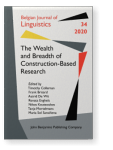How to build a constructicon in five years
The Russian example
We provide a practical step-by-step methodology of how to build a full-scale constructicon resource for a natural
language, sharing our experience from the nearly completed project of the Russian Constructicon, an open-access searchable
database of over 2,200 Russian constructions (
https://site.uit.no/russian-constructicon/). The constructions are organized in families, clusters, and networks based
on their semantic and syntactic properties, illustrated with corpus examples, and tagged for the CEFR level of language
proficiency. The resource is designed for both researchers and L2 learners of Russian and offers the largest electronic database
of constructions built for any language. We explain what makes the Russian Constructicon different from other constructicons,
report on the major stages of our work, and share the methods used to systematically expand the inventory of constructions. Our
objective is to encourage colleagues to build constructicon resources for additional natural languages, thus taking Construction
Grammar to a new quantitative and qualitative level, facilitating cross-linguistic comparison.
Article outline
- 1.Why build a constructicon?
- 2.Features of the Russian Constructicon resource
- 2.1The scope of the project
- 2.2The presentation of constructions
- 3.Reaching and exceeding a critical mass of constructions
- 4.Identifying families: Theoretical motivation and methodology
- 4.1Theoretical motivation
- 4.2Methodology
- 5.Turning a list into a structured inventory
- 6.Conclusion
- Abbreviations
-
References
References (12)
References
Croft, William. 2001. Radical Construction Grammar. Syntactic Theory in Typological Perspective. Oxford: Oxford University Press. 

Dunietz, Jesse, Lori Levin, and Miriam R. L. Petruck. 2017. “Construction Detection in a Conventional NLP Pipeline.” In The papers from the 2017 AAAI Spring Symposium on Computational Construction Grammar and Natural Language Understanding.
Technical Report SS-17-02, 178–184.
Endresen, Anna, Valentina Zhukova, Daria Mordashova, Ekaterina Rakhilina, and Olga Lyashevskaya. 2020. “Russkij konstruktikon: Novyj lingvističeskij resurs, ego ustrojstvo i specifika [The Russian Constructicon: A new linguistic resource, its design and key characteristics].” In Computational Linguistics and Intellectual Technologies. Papers from the Annual International Conference
“Dialogue-2020”, 226–241. Published on-line.
Fillmore, Charles J., and Beryl T. Atkins. 1992. “Toward a Frame-Based Lexicon: The Semantics of RISK and Its Neighbors.” In Frames, Fields, and Contrast: New Essays in Semantics and Lexical Organization, ed. by Adrienne Lehrer, and Eva Kittay, 75–102. Hillsdale, NJ: Lawrence Erlbaum.
Fillmore, Charles J., Paul Kay, and Mary C. O’Connor. 1988. “Regularity and Idiomaticity in Grammatical Constructions: The Case of Let Alone
.” Language 64(3): 501–538. 

Goldberg, Adele. 2006. Constructions at Work. The Nature of Generalization in Language. Oxford: Oxford University Press.
Janda, Laura A., and Steven J. Clancy. 2002. The Case Book for Russian. Bloomington, IN: Slavica Publishers.
Janda, Laura A., Olga Lyashevskaya, Tore Nesset, Ekaterina Rakhilina, Francis M. Tyers. 2018. “A Constructicon for Russian: Filling in the Gaps.” In Constructicography: Constructicon Development Across Languages, ed. by Benjamin Lyngfelt, Lars Borin, Kyoko Ohara, and Tiago T. Torrent, 165–181. Amsterdam: John Benjamins. 

Lyngfelt, Benjamin, Linnéa Bäckström, Lars Borin, Anna Ehrlemark, and Rudolf Rydstedt. 2018. “Constructicography at Work: Theory Meets Practice in the Swedish Constructicon.” In Constructicography: Constructicon Development Across Languages, ed. by Benjamin Lyngfelt, Lars Borin, Kyoko Ohara, and Tiago T. Torrent, 41–106. Amsterdam: John Benjamins. 

Plungian, Vladimir A. 2011. Vvedenie v grammatičeskuju semantiku: Grammatičeskie značenija i grammatičeskie sistemy jazykov
mira [An introduction to grammatical semantics: Grammatical meanings and grammatical systems in the
languages of the world]. Moscow: Russian State University for the Humanities Press.
Rakhilina, Ekaterina V. (ed.) 2010. Lingvistika konstrukcij [Linguistics of constructions]. Moscow: Izdatel’stvo Azbukovnik.
Cited by (3)
Cited by three other publications
Bychkova, Polina & Ekaterina Rakhilina
Zhukova, Valentina
2023.
How to threaten in Russian: a constructionist approach.
Russian Linguistics 47:2
► pp. 141 ff.

Ziem, Alexander & Tim Feldmüller
2023.
Dimensions of constructional meanings in the German Constructicon: Why collo-profiles matter.
Yearbook of the German Cognitive Linguistics Association 11:1
► pp. 203 ff.

This list is based on CrossRef data as of 4 july 2024. Please note that it may not be complete. Sources presented here have been supplied by the respective publishers.
Any errors therein should be reported to them.
